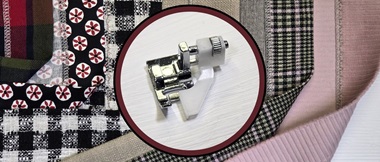
Perfect ruffles, fitting (almost) perfectly, fast!
Ruffling fabric while attaching it to your project at the same time you’re sewing is pretty cool, don’t you think? And super easy if you use the gathering foot on your overlocker.
However, getting the ruffle to fit can be a little tricky, and I have to say, it’s not an exact science. But… with the methods below you will get a close to perfect fit first time.
How much ruffle?
The first thing to consider is that the amount of ruffling is dependent on a few factors:
- The setting on your differential feed.
- The drape and body of your fabric – thinner and more pliable fabrics will gather up more than heavier and stiffer fabrics.
Predicting exactly how much fabric the ruffles will ‘eat’ over a certain distance is the big question. There are three ways to go about working this out:
- Calculating how to fit the ruffle as specified by your pattern.
- Finding the ruffle density you like on some practise strips, and then calculating how long the ruffle needs to be to fit on the edge you want to attach it to.
- Taking a guess :-D and then adjust the strips. This is the fastest method, but there is some waste. Make sure you have a good amount of fabric to spare!


Method 1: calculating how to fit the ruffle as specified by your pattern
You will calculate how long a piece of ruffle will fit on 10cm. Then test and adjust your differential feed (DF) accordingly until you get it near enough.
The Calculation
Measure the length of your ruffle piece.
Measure the length of the part it would be attached to. Divide this value by 10.
Now divide the ruffle length by this value.
Here is an example:
The ruffle piece measures 250cm.
The bottom of the skirt measures 115cm.
115 divided by 10 = 11.5
250 divided by 11.5 = 21.8
This means you must adjust your DF settings to gather 21.8cm of ruffle on a 10cm piece.
Working out the DF settings to make your ruffle fit
You need to adjust your DF settings to get you this measurement. Cut two strips of the same fabric that you’re using for your project:
- 1 x strip at least 50cm long (this is the unruffled piece).
- 1 x strip about 1m long (the top piece you will ruffle.
- They can be around 10cm wide each.
Set your DF at a medium setting and sew about 15cm. Cut the fabric and measure out 10cm on the flat side, and then measure the length of fabric that was ruffled into this measured part. Compare that with your value above (in our example it was 21.8cm).
If it is longer, you want it ruffled less, so adjust your DF to a lower setting. If the ruffled piece is shorter, that means you need denser ruffles, so you need to adjust your DF to a higher setting.
Keep testing until you get a length of ruffled fabric as close as possible to the value you calculated in step 1.
Method 2: determining the denseness of ruffles you would like, and then calculate the ruffle length accordingly
To get an idea of how much ruffling you prefer, sew a test piece. Once you’re happy with the result, mark out 10cm on the flat side, and then measure the length of the corresponding ruffle part. Divide this value by 10. We will call this your Ruffle Factor.
Next, measure the length of fabric the ruffle will be sewn on to. To calculate how long a piece of fabric you need for the ruffle, multiply this value by your Ruffle Factor. I like to allow a little bit extra fabric to be on the safe side – you can always trim this at the end. However, if it is too short you can’t easily add extra fabric to the ruffle! Therefore, I add another 5 or 10 times of the Ruffle Factor.
Here is an example:
I want to add a ruffle to the bottom of a skirt. I did my test, and here is my calculation:
The flat section of 10cm used a ruffle length of 18cm.
18 divided by 10 = 1.8 - So my Ruffle Factor is 1.8.
The bottom edge of the skirt measures 106cm.
So:
(Length onto which ruffle will go) x (Ruffle Factor) = length to cut ruffle
105 x 1.8 = 189
To be safe I want to add an extra 18cm (10 x the Ruffle Factor), so my strip for the ruffle will be 207cm, or 2.07m.
Note on Method A and B
Using either of these methods you may not be entirely accurate over a long length, so allowing some extra length in the ruffle as well as adjusting your construction sequence is recommended.
Instead of sewing the side seams and then ruffling, as you would normally do, Method A and B work best if you leave one side seam undone, attach the ruffled layers and then sew the side seams together afterwards.
See our tips on how to sew the side seams here.
Method 3: taking a guess
While this may sound a little Machiavellian, in some cases it’s a fast and effective way of construction. A skirt with an elasticated waist, for instance, is a good example of where this method can be used with impunity, as a little bit of variation in the measurement won’t matter.
Do a quick test to see if the denseness of the ruffles is good and adjust if necessary.
Cut the ruffle 2 to 2.5 times the length of the band it will be attached to. Attach and trim the excess.
This method works well to make our super speedy summer skirts (see the article here).
What will you ruffle next? Need some inspo? Have you seen our article on how to use the amazing gathering foot on your overlocker?




